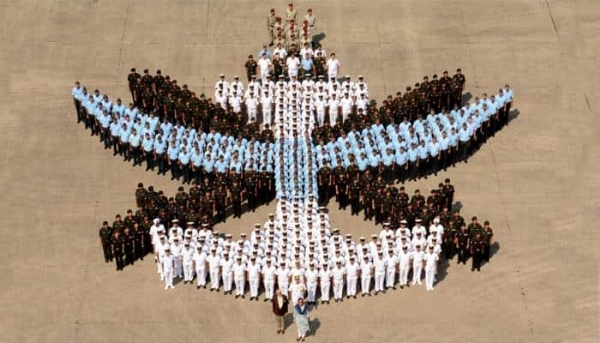NB Explains | Why India needs integrated military commands?
16 Mar 2023 10:59:33
On August 15, 2019, speaking from the ramparts of Red Fort on Independence Day, Prime Minister Narendra Modi announced to establish of the post of chief of defense staff (CDS) to increase coordination between the three services and provide a single point of military advice to the government. One of the first orders of business for the new CDS was to follow up on the government's direction for the establishment of unified theatre commands, as is the norm in most modern militaries.
So, with an aim to move a step towards the creation of joint services commands for the army, air force and navy, the government on Wednesday introduced a bill in Parliament to empower designated military commanders to take charge of soldiers and enforce discipline, regardless of the service they belong to.
So, with an aim to move a step towards the creation of joint services commands for the army, air force and navy, the government on Wednesday introduced a bill in Parliament to empower designated military commanders to take charge of soldiers and enforce discipline, regardless of the service they belong to.
The Inter-services Organisations (Command, Control and Discipline) Bill, introduced in the Lok Sabha by defence minister Rajnath Singh, comes ahead of the impending move to establish integrated or joint commands, where all the manpower and assets of the Indian Army, Navy and IAF will be under the operational control of a single three-star general.

After the nation's first chief of defence staff General Bipin Rawat passed away in a helicopter crash in December 2021, the development of integrated military commands was put on hold. They are once again at the top of the agenda, with General Anil Chauhan taking over as the new CDS in September of last year.
What is the Bill for integrated military commands?
The submission in Parliament clearly refers to the upcoming theatre commands, with the bill stating that it will help "empower the central government to constitute inter-services organisation, by notification, which may include a joint services command, comprising of units or service personnel" subject to existing Acts governing the army, air force and navy.
"The proposed bill will essentially be an enabling legislation, which empowers the heads of the inter-services organisations to exercise effective command, control and discipline on all personnel of regular air force, army and navy and to persons of other forces as notified by the central government, who are serving in or attached to an inter-services organisation, without amending the respective Acts," Singh's submission to parliament reads.
The system is likely to include five joint services commands - western, eastern, northern, maritime, and air defence. Existing commander-in-chief level officers are likely to be integrated into these commands as staff officers, advising the theatre commanders. Efforts to finalise the contours of the new system are being led by CDS Anil Chauhan who is building consensus.
Why India needs integrated military commands?
At present, soldiers from respective services are governed by different Acts of Parliament. At the moment, each military service has its own set of laws and regulations that apply to its members. They are the Navy Act of 1957, the Air Force Act of 1950, and the Army Act of 1950. For example, in a current joint services setup, an army soldier commanded by a navy officer would have to be sent back to his parent unit for any disciplinary proceedings. The navy officer does not have administrative powers over the said soldier.
Besides, currently there are only two unified commands that exist in India at the moment: the geographical Andaman and Nicobar Command and the operational Strategic Forces Command, which manages the nation's nuclear arsenal. These commands were established in 2001 and 2003 following the 1999 Kargil conflict with Pakistan. There are also a few tri-service organisations, such as the Armed Forces Special Operations Division, the Defence Intelligence Agency, the Defence Cyber Agency, and the Defence Space Agency. In contrast, there are up to 17 single-service commands (Army 7, IAF 7, and Navy 3), which have nothing in common in terms of command-and-control structures and planning and operations.
However, if integrated military commands get established, there will be improved troop acclimatisation to the given battle zone. This will help them understand the operational requirements in the designated area of operation. Apart from this, the distribution of military hardware, such as weapon systems, command, control, communication tools, and combat support elements, will be theatre-specific and lead to resource optimization.
Understanding the training needs and administrative requirements of the troops will enable specialisation and appropriate improvement of war drills at all levels. For speedy mobilisation and appropriate use during the anticipated, brief, high-intensity combat, the equipment can be purchased, maintained, and pre-positioned.
Understanding the training needs and administrative requirements of the troops will enable specialisation and appropriate improvement of war drills at all levels. For speedy mobilisation and appropriate use during the anticipated, brief, high-intensity combat, the equipment can be purchased, maintained, and pre-positioned.
It is to be noted that early in 2016, China's 2.3 million-strong People's Liberation Army was reorganised into five theatre commands to improve command-and-control systems and increase offensive capabilities. For instance, the 3,488-km Line of Actual Control from eastern Ladakh to Arunachal Pradesh is managed by its Western Theatre Command. In contrast, India maintains three IAF and four Army commands along its "northern frontiers" with China.
As a result, it is necessary to establish joint commands in order to create an integrated war-fighting apparatus within the restrictions of the budget.